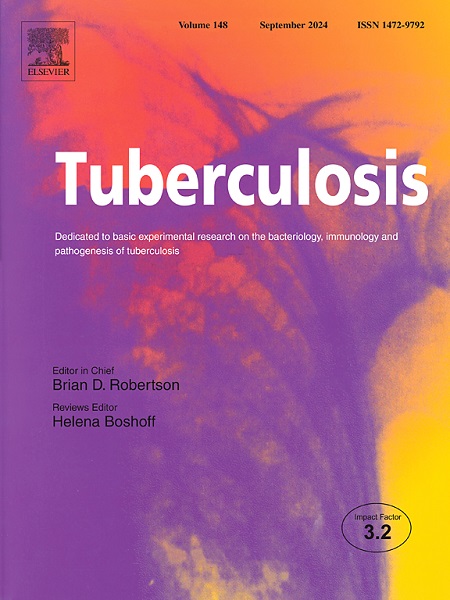Exploring CHIT1 and YKL-40 in tuberculous pleural effusion: Insights and implications
IF 2.9
3区 医学
Q3 IMMUNOLOGY
引用次数: 0
Abstract
Background
Chitinases and chitinase-like proteins are implicated in the pathophysiology of lung diseases. This study aimed to evaluate the significance of chitotriosidase (CHIT1) and YKL-40 in tuberculous pleural effusion (TPE), identify their cellular sources, and assess their diagnostic potential as TPE biomarkers.
Methods
This observational, retrospective study included 66 patients with pleural effusion of different origins: malignant (MPE), tuberculous (TPE), parapneumonic (PPE), and transudative (TE). Pleural fluid levels of YKL-40 and CHIT1 were measured. Expressions of YKL-40 and CHIT1 in tuberculous pleural granulomas were also assessed using immunohistochemical staining.
Results
We found the highest median CHIT1 and YKL-40 levels for TPE: 70.51 (interquartile range [IQR] 49.65–136.98) ng/mL and 569.84 (IQR 530.32–706.01) ng/mL, respectively. YKL-40 was significantly higher in TPE than in PPE (387.98 [IQR 262.94–539.09] ng/mL, p < 0.01)] and TE (254.95 [IQR 188.93–334.1 ng/ml] ng/mL, p < 0.001). There was a strong positive correlation between the YKL-40 level in TPE and the percentage of macrophages (r = 0.73, p = 0.003) and the adenosine deaminase activity (r = 0.82, p < 0.001). We revealed strong YKL-40 expression in tuberculoid pleural granulomas.
Conclusion
YKL-40, but not CHIT-1, may contribute to the pleural inflammatory response associated with tuberculosis.
探讨结核性胸腔积液中CHIT1和YKL-40:见解和意义
几丁质酶和几丁质酶样蛋白参与肺部疾病的病理生理。本研究旨在评估壳三醇苷酶(CHIT1)和YKL-40在结核性胸腔积液(TPE)中的意义,确定它们的细胞来源,并评估它们作为TPE生物标志物的诊断潜力。方法回顾性观察66例不同来源的胸腔积液:恶性(MPE)、结核性(TPE)、肺副性(PPE)和肺泡性(TE)。测定胸膜液中YKL-40和CHIT1水平。免疫组化染色法检测结核性胸膜肉芽肿组织中YKL-40和CHIT1的表达。结果TPE患者的CHIT1和YKL-40水平中位数最高,分别为70.51(四分位间距[IQR] 49.65 ~ 136.98) ng/mL和569.84 (IQR 530.32 ~ 706.01) ng/mL。TPE中YKL-40含量显著高于PPE (387.98 [IQR 262.94-539.09] ng/mL, p < 0.01)和TE (254.95 [IQR 188.93-334.1] ng/mL, p < 0.001)。TPE中YKL-40水平与巨噬细胞百分比(r = 0.73, p = 0.003)和腺苷脱氨酶活性(r = 0.82, p < 0.001)呈极显著正相关。我们发现YKL-40在结核样胸膜肉芽肿中表达强烈。结论ykl -40可能参与结核相关胸膜炎症反应,而CHIT-1不参与。
本文章由计算机程序翻译,如有差异,请以英文原文为准。
求助全文
约1分钟内获得全文
求助全文
来源期刊

Tuberculosis
医学-呼吸系统
CiteScore
4.60
自引率
3.10%
发文量
87
审稿时长
49 days
期刊介绍:
Tuberculosis is a speciality journal focusing on basic experimental research on tuberculosis, notably on bacteriological, immunological and pathogenesis aspects of the disease. The journal publishes original research and reviews on the host response and immunology of tuberculosis and the molecular biology, genetics and physiology of the organism, however discourages submissions with a meta-analytical focus (for example, articles based on searches of published articles in public electronic databases, especially where there is lack of evidence of the personal involvement of authors in the generation of such material). We do not publish Clinical Case-Studies.
Areas on which submissions are welcomed include:
-Clinical TrialsDiagnostics-
Antimicrobial resistance-
Immunology-
Leprosy-
Microbiology, including microbial physiology-
Molecular epidemiology-
Non-tuberculous Mycobacteria-
Pathogenesis-
Pathology-
Vaccine development.
This Journal does not accept case-reports.
The resurgence of interest in tuberculosis has accelerated the pace of relevant research and Tuberculosis has grown with it, as the only journal dedicated to experimental biomedical research in tuberculosis.
 求助内容:
求助内容: 应助结果提醒方式:
应助结果提醒方式:


